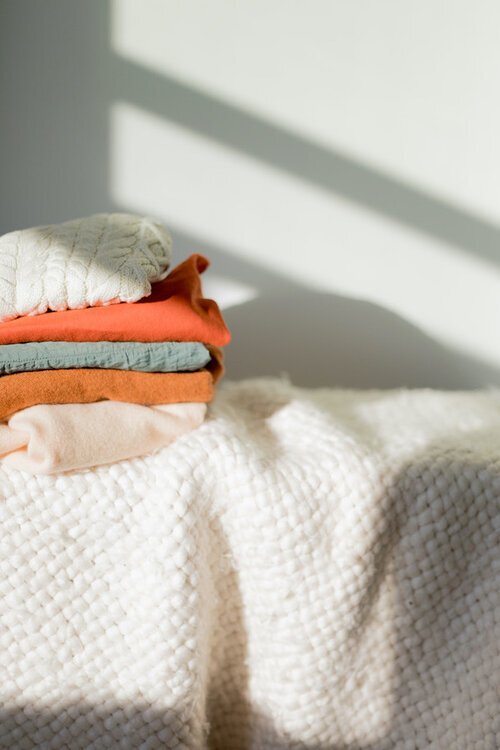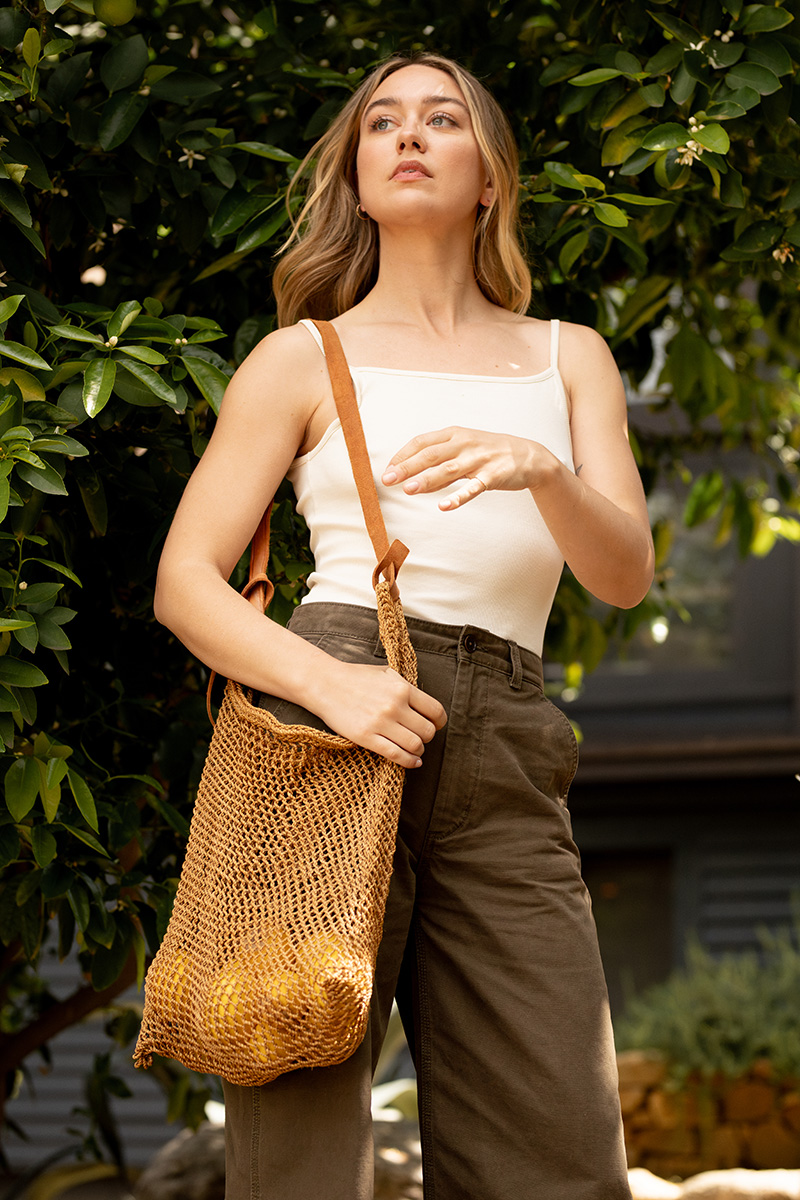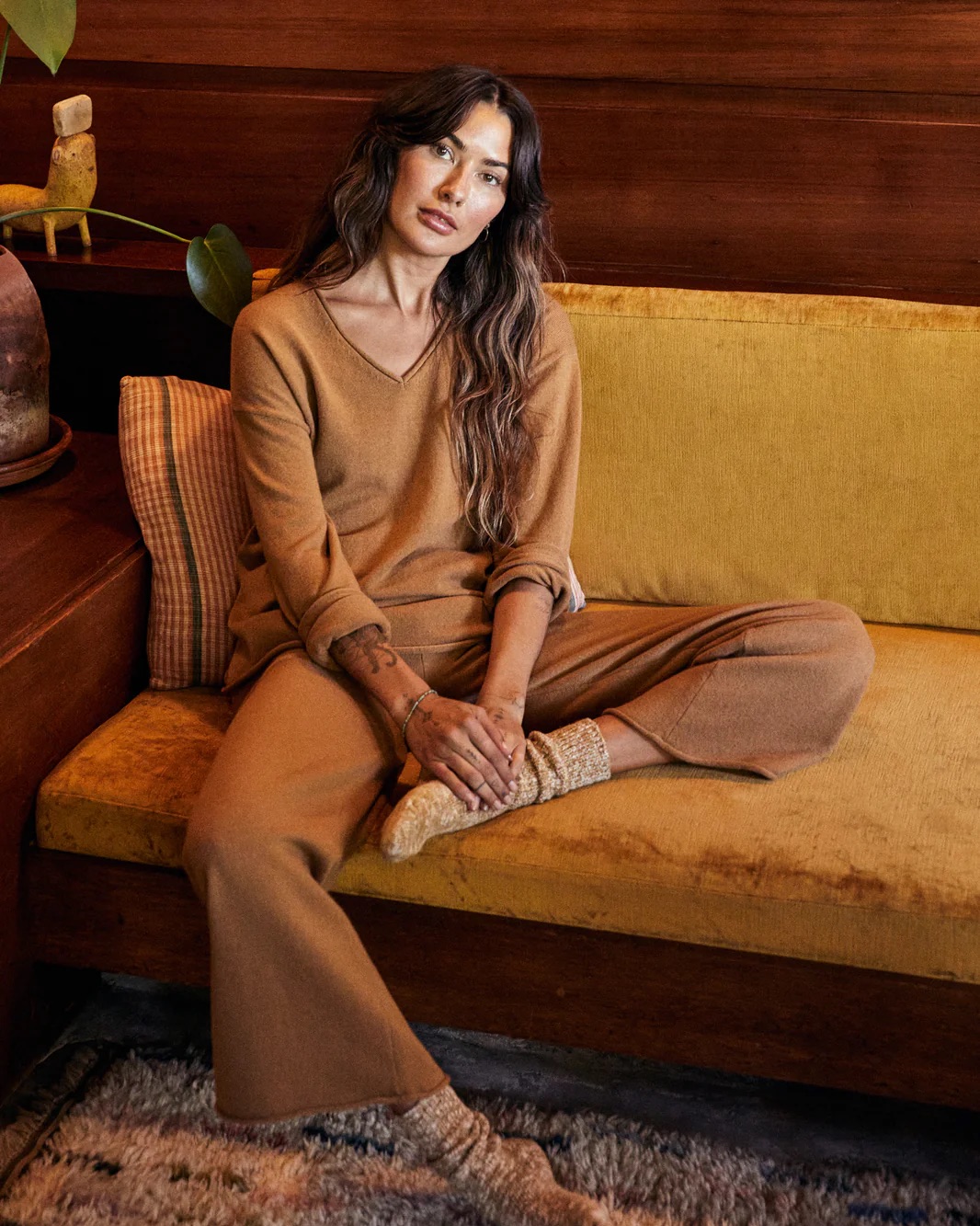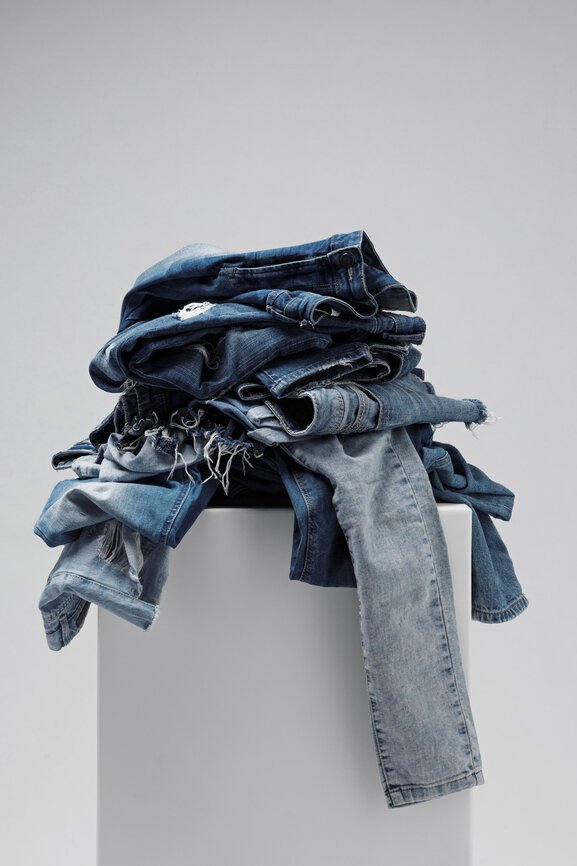
Sustainable Materials And Fabrics You Should Know About
We see the same buzzwordy materials pop up time and time again in slow fashion spaces—organic cotton, reclaimed fabric, linen, tencel. But what do these phrases mean in terms of sustainable clothing? Is all clothing made with these materials necessarily eco-friendly? And what are the absolute most sustainable fabrics?
The answer is complicated, but we dive into it below with the help of a sustainable fashion expert.
Why sustainable fabrics matter
The fast fashion industry, which is the second-largest polluter of water and the third-largest polluter overall, thrives on producing quick, cheap virgin materials, like polyester, spandex, viscose, and nylon. Used to make low-quality clothing, textiles like these make up 8% of municipal waste, and take decades or more to biodegrade, releasing microplastics into the environment during the process.
“How do we tell if a garment is made from a truly sustainable natural fiber fabric?”
So, what fabrics should we look for when purchasing new clothing? Lottie Bertello, founder and design director of LOTI, an upcycling design studio based between Peru and LA, says that upcycled products are king “in terms of resource use and waste reduction.”
And, as a “very general” rule of thumb, she says to stick to natural fibers like organic cotton, linen, hemp, silk, wool, alpaca, and bamboo. “I’ve run into so many Tik Toks of people getting horrible skin rashes after wearing a Shein garment, and it’s like, of course,” she laughs, “you’re wearing a poorly developed textile made mostly from crude oil.”
But how do we tell if a garment is made from a truly sustainable natural fiber fabric? More on that below.
What makes a fabric sustainable?
“Not all natural fibers are created equally,” says Bertello, “and I personally do not consider a fabric sustainable unless it’s ethically made.” Sure, a garment might be handmade in a California studio from hemp—but is the brand telling you that hemp was woven ethically? That’s the marker of a truly sustainable fabric.
“Alpaca is hands down the most sustainable animal fiber out there.”
Lottie Bertello, founder and design director of LOTI
While Bertello loves upcycled fabrics, she also notes that new technologies have helped reduce the amount of energy and water that goes into making fabrics like organic cotton and denim. She also touts the benefits of alpaca, calling it a “highly underrated” textile. “Alpaca is hands down the most sustainable animal fiber out there,” she says, likening it to cashmere in terms of fiber quality, softness, durability, and price. “Alpacas graze in a way that’s gentler on the environment,” she notes, “one alpaca’s wool can provide enough material to make four or five sweaters,” and the material is super economically beneficial to Andean communities.
Bertello’s least favorite fabric? Polyester, and anything made of polyester like fleece, spandex, and viscose. “I’ll admit, I break this rule for “performance” garments like swimwear and sportswear,” she notes, but it’s getting easier to find more sustainable activewear made of cotton with a touch of spandex.
How to shop for sustainable fabrics
A truly ethical brand will make it clear through their platforms that they’re working to use the most environmentally-friendly versions of their materials as possible. When in doubt, ask! Most brands that call themselves ethical will be more than happy to answer an email or DM asking them how they source their fabrics to make sure they were ethically produced. “I love getting messages like this because it tells me the gal who shops at LOTI is curious and cares,” says Bertello.
As always, even with sustainable fabrics, the less you buy, the more sustainable you’ll be. You’re much better off buying a piece that you’ll rewear for years and years rather than several ethically sourced, sustainably made garments that you’ll donate after a year or care for improperly.
“Sustainability is not a product or something that can be bought.”
Lottie Bertello
Websites like Good On You are excellent resources to learn more about a brand’s practices. And keep in mind that there’s no one perfect, sustainable fabric that’ll have zero environmental impact. The idea is that the below list will help you become a more informed consumer, making more consciously ethical decisions when shopping for clothes.
“Sustainability is not a product or something that can be bought,” says Bertello. “It’s a holistic shift to living in harmony with our environment, which means not taking more than we need.” Read on for the lowdown on a handful of the most environmentally sustainable fabrics.
Fabrics glossary
Alpaca
Pros: Alpaca wool is water resistant, and temperature regulating. It takes little to no chemicals to produce, and Alpacas graze in a way that’s less damaging to the environment than sheep. Alpaca wool is biodegradable and often more durable than sheep’s wool.
Cons: Alpaca can be pricey, and you should make sure to look for certified organic and fair trade labels.
Bamboo
Pros: Bamboo is a fast-growing, regenerative crop that requires little or no fertilizer or pesticides. The process to mechanically turn it into bamboo linen requires little or no chemicals.
Cons: It’s almost impossible to know if the bamboo you’re buying was farmed sustainably. And when bamboo is turned into soft garments like sheets and underwear, it must undergo an intensive chemical process, the same way viscose (or rayon) is made—however, in recent years, manufacturers have made improvements in chemical management.
ECONYL®
Pros: Econyl is made of regenerated nylon waste, making it a popular alternative to virgin nylon. It’s upcycled from fishing nets and waste fabrics, using much less water and energy than producing nylon from scratch.
Cons: It’s still made of nylon so it can shed microplastics in the wash—consider using a garment bag or washing as infrequently as possible.
Linen
Pros: Linen is made of flax, a fast-growing plant that traps carbon and doesn’t require fertilizer, pesticides, or much water. Almost the entire flax plant can be woven into linen, so there’s almost no waste left over—and linen is biodegradable and strong.
Cons: You’ll want to read the label to find out if your linen was produced organically. Linen fibers have virtually no stretch, so they wrinkle easily, and linen can be expensive since almost all of it is produced ethically in Europe.
Modal
Pros: A semi-synthetic material, modal is made from a chemical process using the wood of beech trees, which use much less water to grow than crops like cotton. Modal is stretchy and absorbent, making it a good activewear alternative. TENCEL™ Modal, specifically, is made from sustainably farmed trees and a more energy-efficient and less toxic chemical process.
Cons: Like viscose, modal is at least partly synthetic, and some modal is made with harmful chemical processes and untraceable wood.
Organic Cotton
Pros: Soft, stretchy, and breathable, organic cotton is grown with no toxic pesticides, synthetic fertilizers, or genetically modified seeds (GMOs). Look for a GOTS or OCS certification when shopping for organic cotton clothing.
Cons: Cotton takes a lot of water to farm, although organic cotton usually uses less then conventional cotton.
Organic Hemp
Pros: Hemp requires little resources to grow and to spin into threads and fabrics, making it fairly sustainable when grown organically. It’s one of the oldest used textiles, and it has a similar feel to linen—durable and breathable.
Cons: Like bamboo, some hemp is produced through the viscose method which uses lots of chemicals. In this case, it’ll usually be labeled “hemp viscose.” And because of its association with marijuana (it won’t get you high!), it typically requires a special license to grow.
Piñatex
Pros: Piñatex is a leather alternative—and while leather is natural material that lasts for a long time, it’s a byproduct of an industry that’s currently highly unsustainable: cattle ranching. Many vegan leathers are made of plastic, but not Piñatex—it’s made of leftover pineapple leaves that would otherwise be burned.
Cons: It’s not quite as durable as leather, and it won’t fully biodegrade on its own.
Reclaimed (Deadstock)
Pros: Reclaimed, deadstock, or upcycled fabrics are some of the most sustainable fabrics available since they take less energy and resources to make than virgin fabrics.
Cons: Some reclaimed fabrics come from polyester, which still releases microplastics when it’s washed.
RPET
Pros: RPET is recycled polyethylene terephthalate, and it uses about 80% less energy to make than virgin polyester. It has almost identical characteristics to polyester so it’s great for activewear, and it’s made of recycled plastics like water bottles.
Cons: It’s made of plastics, so it can release microplastics when it’s washed—and it can’t be further recycled.
Silk
Pros: Silkworms eat only the leaves of mulberry trees to produce their silk, spinning the fibers into fabric is a fairly low-waste production.
Cons: Because silk comes from caterpillars, it’s not vegan. Some types of silk like ahimsa silk are touted as cruelty-free, but evidence of actual cruelty-free silk is limited.
TENCEL™ Lyocell
Pros: Similar to TENCEL’s modal, their lyocell is made of eucalyptus wood that goes through the viscose process but in a closed loop, so chemicals are reused over and over. Their eucalyptus is sourced sustainably. TENCEL’s lyocell is stretchy and easy to wear, and it’s certified biodegradable.
Cons: They still use a chemical process, making the clothes semi-synthetic.
Wool
Pros: Made by sheep, wool is completely natural, biodegradable, and renewable. It’s a temperature regulator, meaning it keeps you warm in the winter and cool in the summer. Wool is durable, and its production doesn’t have to harm the sheep involved.
Cons: Wool isn’t vegan, and unfortunately, not all sheep farming is alike. Look for certifications that ensure the animals were treated fairly, like the Responsible Wool Standard or the ZQ certification.
Natalie Gale is a Boston-based freelance journalist. When she’s not writing about art, food, or sustainability, you can find her biking to the farmers’ market, baking, sewing, or planning her next Halloween costume. Say hi on Instagram!




